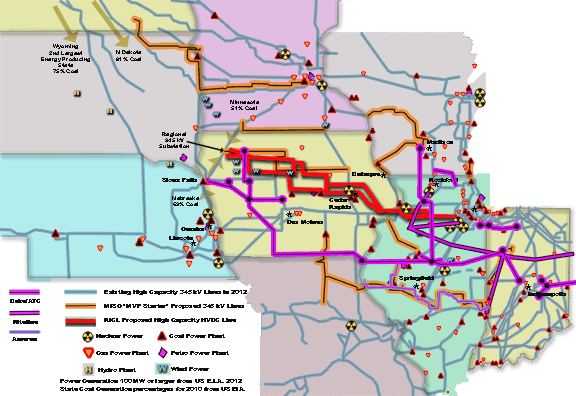Communities in Illinois are under even more pressure for regional high voltage transmission development to move power to the east than we are in Wisconsin. Here’s is a map of a small part of proposed development that I made for several groups there and some talking points that occurred to me as I worked on it:
1. In one of the MISO webinars I attended last year, it was mentioned that our current high capacity grid in the Midwest (the light blue lines) could carry about 39% of the projected wind development the industry says it can’t support. In 2011, our grid in the Midwest was base loaded with a blend that averaged 74% from coal plants and 13% from nuclear plants. The clean-up act dangled before consumers is to make our transmission system “greener,” but this goal becomes less achievable with a fatter grid system. Under current federal policies guiding the wholesale power markets, we ratepayers cannot stipulate that any single proposed transmission project be approved on the basis on carbon emission reduction performance. What goes for one, goes for all. Though we pay for all transmission, we have no way to guarantee environmental performance and do other effective energy planning under these policies. Transmission proposals are now preventing us from addressing key goals like creating sustainable energy jobs where we live, eliminating waste, lowering operation costs and decreasing transmission liabilities.
2. There is probably enough capacity in the current high voltage transmission system to carry all the renewables we can afford to add. Adding remote wind generation seems to be a lot more expensive than other ways to cut carbon emissions. As outlined by Bill Powers in his alternative proposals for San Diego and the Bay Area (great video), the most cost effective, job-generating solution is: (A) Dramatically cutting use with aggressive energy efficiency (B) Developing on site distributed generation which frees-up existing transmission to carry greater amounts of renewable energy while improving reliability. Wider adoption of distributed generation including rooftop solar becomes competitive when the money we are being asked to spend for enormous transmission system expansions is put on the planning table
3. Looking at results in Massachusetts, for every million dollars invested in Aggressive Energy Efficiency, electricity dependency can be cut by 1 Megawatt. Here in the Midwest, that Megawatt is 74% coal-generated on average. With smaller, more flexible investments than transmission expansion, studies suggest that we can cut use by 15% and directly cut carbon emission about 7-12% in the first 3-4 years. A goal reduction of cutting use 50% is achievable –on par with world efficiency standards. As for benefits, for each million invested into AEE, we get 42 jobs every year the program is funded; it lowers home/farm/business operation costs; it increases demand side management and system reliability and it opens up 1 Megawatt of space for locally produced renewable power and remote renewable power to be carried on our existing lines.
4. For every million dollars invested in remote wind power and expanding our national High Voltage Transmission system, we get 1/6 of Megawatt of power; about 12 jobs for only 3-5 years and lots of new infrastructure to keep safe from terrorists. These additions come with 40 years of inescapable debt, they insure increased home/farm/business operation costs, they do not curb carbon emissions overall because continuing to grow our waste quickly overtakes the small percentage of “green” we can afford to generate remotely.
5. If we build this west to east fattened pipe system like utilities desire, without accountability, we are guaranteed to go backwards in every way that counts: job creation, home/farm/business operation costs, the environment and reducing liabilities/dependencies on centralized power. How could remote wind make our act “dirtier?” By far, the largest existing generation capacity in the Midwest is coal. Building a significant amounts of remote generation is essentially cost prohibitive. In 2010, all of the wind farms in Iowa generated the equivalent of a 1070 Megawatt power plant– about the size of one, large coal plant. There are a good number of those on the map. Regional renewable generation was about 5-7% in 2010. On whose backs do we place the enormous funds needed to double or triple or quadruple these remote facilities? We pick it up in our rates and we pay for the transportation system.
6. “Wind Power from the Plains” sounds great but its not likely to achieve significant carbon emission reductions, especially affordably. Regional utilities have no intention of rolling back their production as a result of high capacity line additions. Consider this example: Wyoming, the 2nd largest energy producer in the county has a portfolio that in 2010 was 75% coal generation and 17% hydro. If we were to fatten the pipes that run out of Wyoming today by removing all transmission “congestion,” the blend would likely jump to 89% coal and 7% hydro power based on DOE analysis. Compare the cost to make that 89% mix “green” at $5,000,000 per Megawatt opposed to making the changes in our homes, farms, businesses and communities at $1,000,000 per Megawatt. Our challenge is not about what kind of power we generate, its about comprehensive, goal driven, accountable energy management. Its about top-down, centralized, liable power or being able to exercise self initiative towards greater energy self sufficiency. Its a matter of becoming aware that these options exist and getting our states to allow us to make investments that will make fulfilling work for us.

